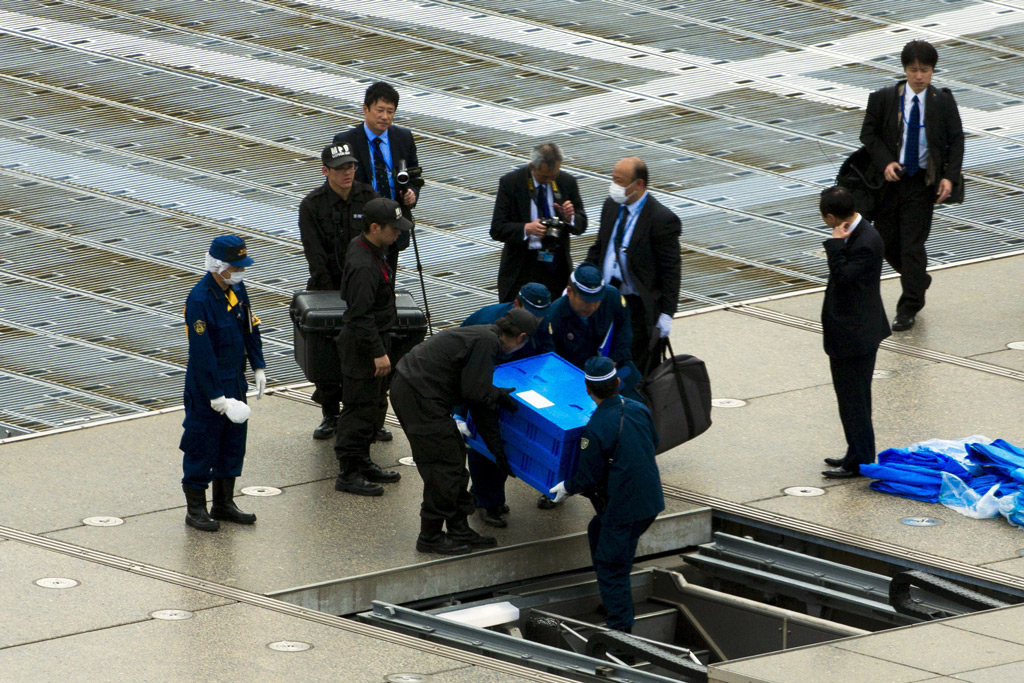
Robohub.org
The Drone Center’s Weekly Roundup: 4/27/15

Japanese security members carry a box containing a drone that was landed on the roof of the Prime Minister’s residence in Tokyo. Credit: Thomas Peter/Reuters
Earlier this month, the United Nations held a Meeting of Experts to discuss the ethical and legal implications of lethal autonomous weapons systems (LAWS). The Meeting, which was attended by delegates of member states, as well as a variety of NGOs and think tanks, reflected a diversity of opinions and policy agendas. To make sense of it all, we have put together a definitive postgame analysis.
The Disposition Matrix is a secret U.S. kill list of senior leaders of al-Qaeda and its affiliates. It is the centerpiece of the Obama administration’s efforts to fundamentally dismantle these organizations. But it also raises questions about how many drone strikes do indeed kill known terrorist leaders. In order to facilitate research and debate on targeted killings, we have reverse engineered the disposition matrix using publicly available data on drone strikes.
News
In a press conference, President Obama acknowledged that a CIA drone strike in January had accidentally killed Warren Weinstein, an American, and Giovanni Lo Porto, an Italian. The two aid workers were being held hostage by al-Qaeda in Pakistan. Umar Farooq and Adam Gadahn, two Americans who were working with al-Qaeda, were also killed in CIA drone strikes in recent months. (New York Times)
A U.S. drone strike reportedly killed seven suspected members of al-Qaeda in Yemen. The strike took place in Mukalla, a southern port city. Earlier in the month, a U.S. drone strike in Mukalla killed Ibrahim al-Rubeish, an al-Qaeda spokesperson. (Reuters)
A man was arrested for landing a drone carrying trace amounts of radioactive material on the roof of Prime Minister Shinzo Abe’s office in Tokyo, Japan. Yasuo Yamamoto, 40, who turned himself in to police on Friday, was protesting Japan’s nuclear energy policies. Attached to the drone were smoke flares and a small water bottle containing cesium, a radioactive material commonly found at nuclear power plants. (BBC)
Between April 21 and 23, The Federal Aviation Administration granted 35 exemptions to companies that wish to fly drones commercially. The new round of permissions, which are known as 333 exemptions, raise the total number of accepted petitions to 224. (FAA)
Commentary, Analysis, and Art
At IHS Jane’s 360, Nicholas Blanford reports that satellite imagery of an airstrip in southern Lebanon could be a base for Hezbollah drones.
At Reuters, Warren Strobel and Mark Hosenball contend that the deaths of Warren Weinstein and Giovanni Lo Porto are a reminder that drones have not made it any easier to track the locations of hostages held by al-Qaeda and the Taliban.
At the Bureau of Investigative Journalism, Chris Woods and Jack Serle report that around 38 Westerners have been killed in U.S. drone strikes.
At Defense One, David Medine and Eliza Sweren-Becker recommend that the Privacy and Civil Liberties Oversight Board carry out oversight of the U.S. targeted killing campaign.
At The New Yorker, Steve Coll asks, How can the strategic value of drone strikes “be squared with the accumulating record of mistakes?”
At Slate, William Saletan argues that the use of drones causes fewer civilian casualties than other forms of warfare.
At the New York Times, the Editorial Board argues that “the White House should go further to provide a fuller accounting of what it knows about the number of civilians killed by the drone-based counterterrorism campaign.”
Also at the New York Times, Mark Mazzetti and Matt Apuzzo consider the support among lawmakers in Congress for the continuation of U.S. drone strikes.
At The Intercept, Dan Froomkin writes that the administration’s refusal to use the word “drone” is a serious problem.
At Lawfare, Robert Chesney maps out some of the key questions in the debate over targeted killing.
Also at Lawfare, Cody Poplin explains that Ibrahim al-Rubeish was likely a lawful target for a U.S. drone strike.
At Just Security, Michael Schmitt and John Merriam examine Israel’s targeting practices.
At War on the Rocks, Aaron Zelin and Patrick Hoover look at how the tactics of al-Qaeda in the Arabian Peninsula have changed since the fall of Yemen’s government.
At the Bulletin of Atomic Scientists, Hugh Gusterson argues that Gregoire Chamayou’s Theory of the Droneprovides a valuable perspective on violence inside the United States.
At Popular Science, Kelsey Atherton tracks one company’s efforts to protect the Boston Marathon from drones.
At the Christian Science Monitor, Mary Cirincione considers whether the influx of drones into the domestic airspace will require new privacy laws to be developed.
At the Electronic Frontier Foundation, Jeremy Gillula argues that the FAA’s proposed rules should not restrict non-recreational users of drones like researchers, journalists, and artists.
At the Drone Journalism Lab, Matthew Waite published his comments on the FAA’s Notice of Proposed Rulemaking (NPRM). The comments suggest ways that the FAA can make it easier for journalists to use drones.
At the Mercatus Center, Eli Dourado, Ryan Hagemann, and Adam Thierer argue that the FAA’s NPRM should include space for “permissionless innovation” in order to speed the growth of this technology.
In its NPRM comment, the Small UAV Coalition lends support to the FAA’s overall framework for integrating drones into the national airspace and considers how new technologies could be accomodated in future rules.
The Association for Unmanned Vehicle Systems International commented that while the NPRM is a “good first step in an evolutionary process,” in many ways it is too restrictive.
Know Your Drone
A team at the Marine Future Warfighting Laboratory demonstrated how an unmanned ground vehicle and a multicopter drone were able to work autonomously in unison. (Defense One)
A team at the Massachusetts Institute of Technology has developed a quadrotor drone capable of floating on water. (BBC)
Defense contractor General Atomics has declared that its third-generation laser weapon can be mounted on both destroyer ships and its Avenger combat drone. (Aviation Week)
IKEA predicts that by 2025, much of our food will be delivered by drone, so we will need less storage and refrigeration space in our kitchens. (City Lab)
The U.S. Coast Guard is hoping to acquire a search-and-rescue drone within the next few years. (Navy Times)
A researcher at the University of Sydney has developed a system that allows drones to autonomously dock to another aircraft in order to refuel or recharge in mid-flight. (Press Release)
A TEPCO shape-shifting robot that was sent into the Fukushima reactor No. 1 has become stuck after travelling about 20 ft. (IEEE Spectrum)
South Korea has unveiled a tilt-rotor drone capable of flying at speeds of over 300 mph for up to six hours. (Popular Mechanics)
Oregon State University has announced that it will build a drone testing facility to develop unmanned systems and train pilots. (AUVSI)
And U.S. Postal Service trucks of the future could double as drone launchers. (USA Today)
Drones at Work
Researchers in Norway are using drones to measure the effects of climate change. (Climate Central)
The Syrian Airlift Project aims to use drones to fly food and medicine into war-torn areas of Syria. (BBC)
After an 18-month investigation by the National Counter Terrorism Policing Headquarters, police in the U.K. will begin using drones to enhance security at airports. (BBC)
A team of researchers at the University of Queensland are using drones to retrace the movements of dinosaurs around Australia. (Mashable)
Swiss WorldCargo and Swiss Post will begin working with Matternet to test delivery drones. (TechCrunch)
A man in Tennessee used a drone to keep an aerial eye on his daughter as she walked to school alone. (WVLT TV)
The Weekly Drone Roundup is a newsletter from the Center for the Study of the Drone. It covers news, commentary, analysis and technology from the drone world. You can subscribe to the Roundup here.
tags: c-Aerial, drones, UAVs




